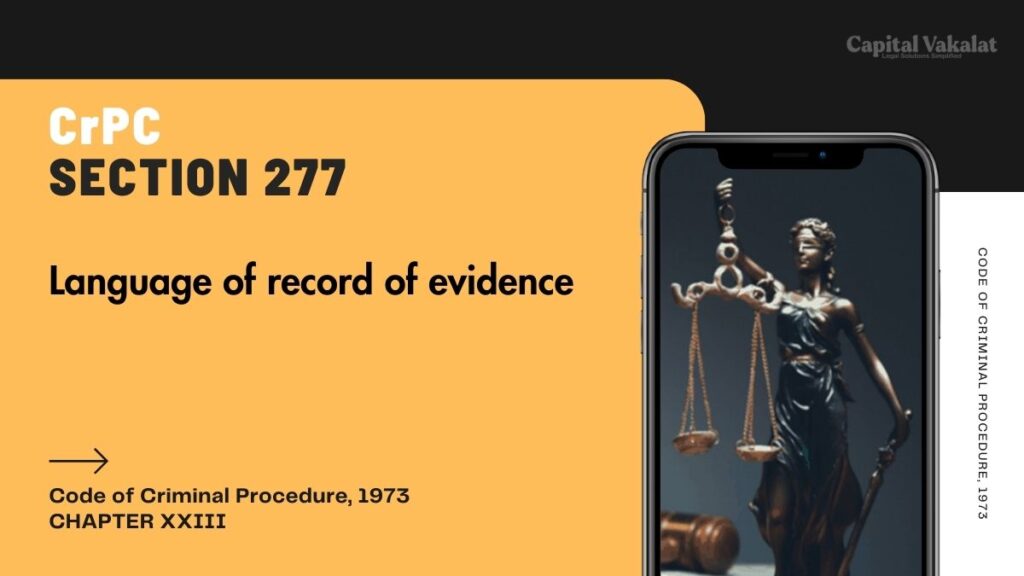Section 277 of the Criminal Procedure Code (CrPC) plays a crucial role in ensuring justice is served by outlining the language used for recording evidence in court proceedings. This article delves into the intricate details of this section, providing a comprehensive understanding for legal professionals and the general public alike.

The Criminal Procedure Code of 1973 revolutionized the Indian legal system. Among its many sections, Section 277 holds significant importance in maintaining the integrity and clarity of judicial proceedings. Understanding its historical evolution helps in appreciating its current application.
Bare Act. Section 277 Cr.P.C.
Language of record of evidence.
In every case where evidence is taken down under section 275 or 276,---
(a) if the witness gives evidence in the language of the Court, it shall be taken down in that language;
(b) if he gives evidence in any other language, it may, if practicable, be taken down in that language, and if it is not practicable to do so, a true translation of the evidence in the language of the Court shall be prepared as the examination of the witness proceeds, signed by the Magistrate or presiding Judge, and shall form part of the record;
(c) where under clause (b) evidence is taken down in a language other than the language of the Court, a true translation thereof in the language of the Court shall be prepared as soon as practicable, signed by the Magistrate or presiding Judge, and shall form part of the record:
Provided that when under clause (b) evidence is taken down in English and a translation thereof in the language of the Court is not required by any of the parties, the Court may dispense with such translation.
Legislative Intent Behind Section 277 CrPC
The legislative intent behind Section 277 CrPC was to standardize the language used in court records to prevent ambiguities and misinterpretations. This standardization ensures that the evidence is recorded accurately, maintaining the sanctity of judicial proceedings.
The Language of Record of Evidence
Section 277 specifies the languages in which evidence should be recorded in Indian courts. Typically, the language of the state where the court is located is used. This section mandates that evidence must be recorded in the language understood by the witness, or if not possible, translated into the court’s language.
Practical Implications of Section 277 CrPC
The practical implications of this section are vast. It affects how evidence is perceived and interpreted by judges, lawyers, and juries. Accurate recording in the correct language is paramount to ensuring fair trials.
Challenges in Implementing Section 277 CrPC
Implementing Section 277 is not without its challenges. Multilingual witnesses and complex translations can lead to miscommunications and errors in legal documents. Courts often face the dilemma of choosing between the witness’s language and the official court language.
Case Studies Highlighting Section 277 CrPC
Several case studies demonstrate the application and challenges of Section 277. These cases highlight the importance of accurate language recording in ensuring justice is served and the potential consequences of errors.
Role of Interpreters in Courtrooms
Interpreters play a vital role in the application of Section 277. Their accuracy and proficiency can make or break a case, ensuring that the evidence is correctly understood and recorded.
Training for Legal Professionals
Legal professionals must be adequately trained in the nuances of Section 277. Continuous education and training programs help them navigate the complexities of language recording in court proceedings.
Technological Advancements in Recording Evidence
Technology is increasingly playing a role in recording evidence. Digital transcription tools and language translation software are becoming invaluable in courts, aiding in the accurate recording of evidence as stipulated by Section 277.
Comparative Analysis with Other Jurisdictions
Comparing Section 277 with similar provisions in other jurisdictions provides a broader perspective. It highlights the unique challenges and solutions adopted by different legal systems in managing the language of record of evidence.
Future Prospects and Reforms
The future of Section 277 may see reforms aimed at further simplifying and standardizing the language recording process in courts. Anticipated changes and advancements could potentially address current challenges and improve the overall judicial process.
Conclusion
Section 277 of the CrPC is a cornerstone in the Indian judicial system, ensuring that evidence is recorded in an accurate and comprehensible manner. Understanding its application, challenges, and future prospects is essential for legal professionals and those interested in the justice system.